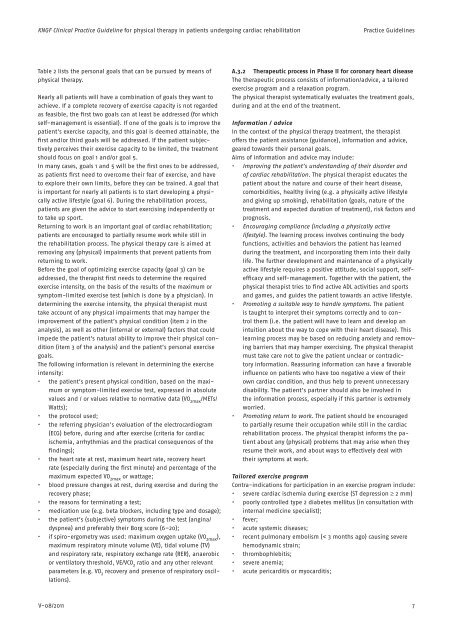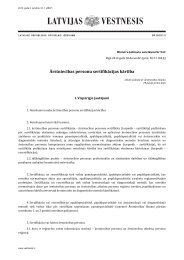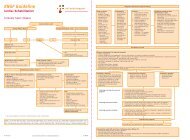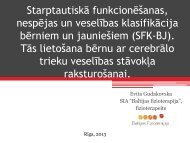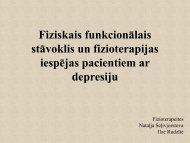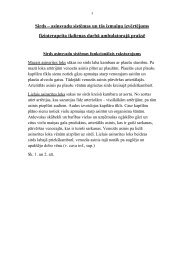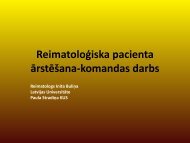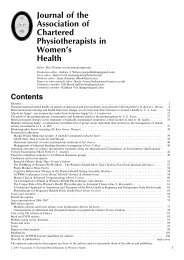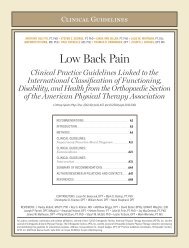KNGF Guideline Cardiac rehabilitation
KNGF Guideline Cardiac rehabilitation
KNGF Guideline Cardiac rehabilitation
Create successful ePaper yourself
Turn your PDF publications into a flip-book with our unique Google optimized e-Paper software.
<strong>KNGF</strong> Clinical Practice <strong>Guideline</strong> for physical therapy in patients undergoing cardiac <strong>rehabilitation</strong><br />
Practice <strong>Guideline</strong>s<br />
Table 2 lists the personal goals that can be pursued by means of<br />
physical therapy.<br />
Nearly all patients will have a combination of goals they want to<br />
achieve. If a complete recovery of exercise capacity is not regarded<br />
as feasible, the first two goals can at least be addressed (for which<br />
self-management is essential). If one of the goals is to improve the<br />
patient’s exercise capacity, and this goal is deemed attainable, the<br />
first and/or third goals will be addressed. If the patient subjectively<br />
perceives their exercise capacity to be limited, the treatment<br />
should focus on goal 1 and/or goal 5.<br />
In many cases, goals 1 and 5 will be the first ones to be addressed,<br />
as patients first need to overcome their fear of exercise, and have<br />
to explore their own limits, before they can be trained. A goal that<br />
is important for nearly all patients is to start developing a physically<br />
active lifestyle (goal 6). During the <strong>rehabilitation</strong> process,<br />
patients are given the advice to start exercising independently or<br />
to take up sport.<br />
Returning to work is an important goal of cardiac <strong>rehabilitation</strong>;<br />
patients are encouraged to partially resume work while still in<br />
the <strong>rehabilitation</strong> process. The physical therapy care is aimed at<br />
removing any (physical) impairments that prevent patients from<br />
returning to work.<br />
Before the goal of optimizing exercise capacity (goal 3) can be<br />
addressed, the therapist first needs to determine the required<br />
exercise intensity, on the basis of the results of the maximum or<br />
symptom-limited exercise test (which is done by a physician). In<br />
determining the exercise intensity, the physical therapist must<br />
take account of any physical impairments that may hamper the<br />
improvement of the patient’s physical condition (item 2 in the<br />
analysis), as well as other (internal or external) factors that could<br />
impede the patient’s natural ability to improve their physical condition<br />
(item 3 of the analysis) and the patient’s personal exercise<br />
goals.<br />
The following information is relevant in determining the exercise<br />
intensity:<br />
• the patient’s present physical condition, based on the maximum<br />
or symptom-limited exercise test, expressed in absolute<br />
values and / or values relative to normative data (VO 2max /METs/<br />
Watts);<br />
• the protocol used;<br />
• the referring physician’s evaluation of the electrocardiogram<br />
(ECG) before, during and after exercise (criteria for cardiac<br />
ischemia, arrhythmias and the practical consequences of the<br />
findings);<br />
• the heart rate at rest, maximum heart rate, recovery heart<br />
rate (especially during the first minute) and percentage of the<br />
maximum expected VO 2max or wattage;<br />
• blood pressure changes at rest, during exercise and during the<br />
recovery phase;<br />
• the reasons for terminating a test;<br />
• medication use (e.g. beta blockers, including type and dosage);<br />
• the patient’s (subjective) symptoms during the test (angina/<br />
dyspnea) and preferably their Borg score (6–20);<br />
• if spiro-ergometry was used: maximum oxygen uptake (VO 2max ),<br />
maximum respiratory minute volume (VE), tidal volume (TV)<br />
and respiratory rate, respiratory exchange rate (RER), anaerobic<br />
or ventilatory threshold, VE/VCO 2 ratio and any other relevant<br />
parameters (e.g. VO 2 recovery and presence of respiratory oscillations).<br />
A.3.2 Therapeutic process in Phase II for coronary heart disease<br />
The therapeutic process consists of information/advice, a tailored<br />
exercise program and a relaxation program.<br />
The physical therapist systematically evaluates the treatment goals,<br />
during and at the end of the treatment.<br />
Information / advice<br />
In the context of the physical therapy treatment, the therapist<br />
offers the patient assistance (guidance), information and advice,<br />
geared towards their personal goals.<br />
Aims of information and advice may include:<br />
• Improving the patient’s understanding of their disorder and<br />
of cardiac <strong>rehabilitation</strong>. The physical therapist educates the<br />
patient about the nature and course of their heart disease,<br />
comorbidities, healthy living (e.g. a physically active lifestyle<br />
and giving up smoking), <strong>rehabilitation</strong> (goals, nature of the<br />
treatment and expected duration of treatment), risk factors and<br />
prognosis.<br />
• Encouraging compliance (including a physically active<br />
lifestyle). The learning process involves continuing the body<br />
functions, activities and behaviors the patient has learned<br />
during the treatment, and incorporating them into their daily<br />
life. The further development and maintenance of a physically<br />
active lifestyle requires a positive attitude, social support, selfefficacy<br />
and self-management. Together with the patient, the<br />
physical therapist tries to find active ADL activities and sports<br />
and games, and guides the patient towards an active lifestyle.<br />
• Promoting a suitable way to handle symptoms. The patient<br />
is taught to interpret their symptoms correctly and to control<br />
them (i.e. the patient will have to learn and develop an<br />
intuition about the way to cope with their heart disease). This<br />
learning process may be based on reducing anxiety and removing<br />
barriers that may hamper exercising. The physical therapist<br />
must take care not to give the patient unclear or contradictory<br />
information. Reassuring information can have a favorable<br />
influence on patients who have too negative a view of their<br />
own cardiac condition, and thus help to prevent unnecessary<br />
disability. The patient’s partner should also be involved in<br />
the information process, especially if this partner is extremely<br />
worried.<br />
• Promoting return to work. The patient should be encouraged<br />
to partially resume their occupation while still in the cardiac<br />
<strong>rehabilitation</strong> process. The physical therapist informs the patient<br />
about any (physical) problems that may arise when they<br />
resume their work, and about ways to effectively deal with<br />
their symptoms at work.<br />
Tailored exercise program<br />
Contra-indications for participation in an exercise program include:<br />
• severe cardiac ischemia during exercise (ST depression ≥ 2 mm)<br />
• poorly controlled type 2 diabetes mellitus (in consultation with<br />
internal medicine specialist);<br />
• fever;<br />
• acute systemic diseases;<br />
• recent pulmonary embolism (< 3 months ago) causing severe<br />
hemodynamic strain;<br />
• thrombophlebitis;<br />
• severe anemia;<br />
• acute pericarditis or myocarditis;<br />
V-08/2011<br />
7


